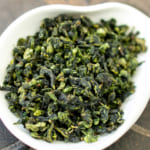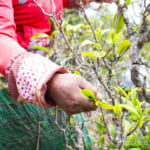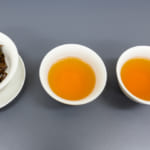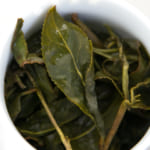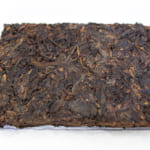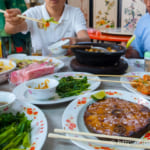- HOME >
- How to choose quality tea
Seeking for Limited Tea Only Available in May
We arrived Yunnan in March and have been staying for more than one month.
In Lincang, spring tea starts around 20th of March. On the other hand, certain teas only available for the first plucking in May. As much people cherish the earliest fresh tea of the year, little people know that the higher the quality of tea, the later in the season it grows. This is the reason we stayed in Yunnan for a long time in order to secure the quality material.
The late-plucked of the first flush tea is of superb quality
It is well-known fact that the first-plucked spring tea is the best in quality. After the first spring tea is plucked, tea will develop the next bud again and it is so-called the second flush or second plucking.In the south of Yunnan, they can pluck nearly 10 times a year if they continue plucking.
Many people tend to think that the earlier the plucking, the better the quality. It is definitely true that the first plucking is the best. However, this theory only works within the same tea tree. If we compare the first-plucked tea within the same region, the tea available later for the first-plucking is obviously of higher quality. It is the same as the meat of animal or fish. For example, farm fish grows faster and its taste is much lighter.
When I stay in Japan in spring, I love to go to mountains for collecting wild herbs. I observed exactly the same trend. In the beginning of season, the budding of wild herbs begins from lower altitude. The herbs from the higher altitude, particularly those from older tree grow slowly and it’s only available nearly a month later. These later-grow wild herbs have extraordinarily thick taste, with three-dimensional mouth-feel and lingering sweetish taste on our palate.
In Asia, people tend to chase after the early crop. But we must bear in our mind that as long as it is the first plucking, the later the season, the better the quality.
The view from 2300m
Altitude, Fertilizer and Latitude is the main factor that affects the growing speed
The main factors affecting the growing speed of tea is altitude, latitude, age of tea tree and fertilizer. In particular, I am very interested in the old tea tree grown without fertilizer and at high altitude.
At high altitude above 2200m, the plucking of the first flush starts in May. Some very old tea trees do not even produce the spring tea yet in the mid of May. However, the budding of fertilized tea tree is pretty much faster even if tea garden is located at higher altitude or tea tree is very old.
May plucked tea consists of high-quality tea and 2nd pluck tea
If there is rainfall in May, the second leaf of tea tree at lower altitude starts growing. Some manufacturers may blend the second-plucked leaf with the first-plucked leaf. So, it is very important for us to clearly manage the source of tea.


Photo above: Old tea tree grown under the shade
The late first-plucked tea is available only if weather is good
We know that the first plucked tea grown later stage is of extremely good quality. However, this premium quality is not available every year.
In Lincang, there is often heavy rainfalls after mid of April. If rain continues for a long time, all kinds of tea regardless of old tree or tea at higher altitude will grow rapidly. As a result, the quality will significantly decrease. So, it’s like a “gambling” for us to decide in which timing we should purchase tea.
In 2017, the rain started after mid of April and continued until end of May. As we were aware of the abnormal weather, we have completed the sourcing of tea by mid of April. If we had been waiting for tea until the end of May, we might not have purchased sufficient tea last year. In contrast, this year the weather forecast looked quite good. Moreover, due to extremely dry weather in the beginning of this year, tea was growing very slowly. In particular those tea trees grown without fertilizer at high altitude, until May the budding was not even started. So, we decided not to purchase a lot of tea in April. Instead, we had spent our time visiting many tea gardens to inspect the environment condition and quality, and we have conducted series of trial-run for improving the production process.
This year we were good in luck. On the first week of May, there was rain for about three days and then stopped. Therefore, in May, we are able to collect the first-pluck tea from the old trees or high mountain tea. Soon we will release some of these teas.
Related Articles
How to get the latest update on HOJO Tea?
1. Follow Twitter, 2. Click "Like" on Facebook, and 3. Subscribe in newsletter. You can have the latest tea news from HOJO Tea.
 Subscribe the Newsletter to enjoy the privileges
Subscribe the Newsletter to enjoy the privileges- You may receive a free sample upon purchase, or you may have the priority to purchase special products. So please remember to subscribe our newsletter as well as the social network.
- New Release of Anxi Traditional Oolong
- Anxi, located in Fujian province, China, is celebrated for its Tie Guan Yin tea. However, the Traditional Anxi Oolong from this region boasts a unique fruity aroma, distinguishing it from Tie Guan Yin. Anxi: A Renowned Hub for Oolong Tea Production in China Fujian Province, renowned for its rich tea heritage, boasts several prominent tea-producing …
- New Release of Lan Yun Tie Guan Yin from Anxi
- Lan Yun Tie Guan Yin from Anxi, is not just an ordinary Tie Guan Yin. It has a strikingly delightful flavor reminiscent of orchid flowers with silky-soft drinking sensation. Anxi, renowned as one of the three major Oolong tea production regions in China. Anxi is recognized as one of the three major Oolong tea-producing regions …
NEW ARTICLES
 New Release of Anxi Traditional Oolong
New Release of Anxi Traditional Oolong- Anxi, located in Fujian province, China, is celebrated for its Tie Guan Yin tea. However, the Traditional Anxi Oolong from this region boasts a unique fruity aroma, distinguishing it from Tie Guan Yin. Anxi: A Renowned Hub for Oolong Tea Production in China Fujian Province, renowned for its rich tea heritage, boasts several prominent tea-producing …
 Yunnan 2024 Spring Tea Sourcing
Yunnan 2024 Spring Tea Sourcing- Yunnan Province is globally renowned for the exceptional quality of its tea leaves. However, lax production management often presents challenges in achieving the desired tea quality when relying solely on pre-made teas. To address this issue, we have committed to remaining on-site throughout the spring season to closely monitor tea production. We are meticulously inspecting …
 The Relationship Between Greenness of Tea Leaves and Fertilizer
The Relationship Between Greenness of Tea Leaves and Fertilizer- For both tea and vegetables, there’s a common misconception that a deeper green colour indicates better quality and greater health benefits. However, this isn’t always the case. Natural plants often have a yellowish-green hue rather than a vibrant green. If you observe wild plants in grasslands or along roadsides during spring, you’ll notice that they …
 Creating Muscatel Black Tea Using a Unique Blending Method
Creating Muscatel Black Tea Using a Unique Blending Method- I would like to introduce the unique creation of black tea with a distinctive muscatel flavor profile. Acquiring Exceptional Mi Xiang Black Tea Have you ever heard of a unique black tea called “Mi Xiang Black Tea” or “Muscatel Black Tea”? This tea is crafted from leaves that have been delicately nibbled by leafhoppers, resulting …
 New Release of Lan Yun Tie Guan Yin from Anxi
New Release of Lan Yun Tie Guan Yin from Anxi- Lan Yun Tie Guan Yin from Anxi, is not just an ordinary Tie Guan Yin. It has a strikingly delightful flavor reminiscent of orchid flowers with silky-soft drinking sensation. Anxi, renowned as one of the three major Oolong tea production regions in China. Anxi is recognized as one of the three major Oolong tea-producing regions …
 The Difference Between Fermentation in Tea and Fermented Foods
The Difference Between Fermentation in Tea and Fermented Foods- Black tea and oolong tea are often categorized as “fermented teas,” but the extent to which they undergo fermentation raises questions about whether they truly qualify as fermented foods. In this article, I endeavour to offer a thorough exploration of the distinctions between tea and traditional fermented foods, shedding light on the nuances of their …
 Easy Way to Prepare Flavorful and Warm Tea at the Workplace
Easy Way to Prepare Flavorful and Warm Tea at the Workplace- Have you ever experienced the transformation of tea stored in a thermos or water bottle at work, turning into a brown hue and acquiring a bitter, astringent taste? As this has piqued the interest of many, I would like to offer a more in-depth explanation for a solution. Tea stored in a thermos undergoes oxidation …
 The new release of Bao Dao Shan Da Cha Tou Brick 2017, exclusively crafted from Da Cha Tou leaves
The new release of Bao Dao Shan Da Cha Tou Brick 2017, exclusively crafted from Da Cha Tou leaves- Bao Dao Shan Cha Tou Zhuan 2017 is a ripe pu-erh tea crafted into brick form. Bao Dao Shan is the name of the mountain situated in the southwestern part of Yunnan. “Cha Tou” denotes a distinctive type of ripe pu-erh tea. In the course of fermenting spring tea, certain tea clumps naturally develop, known …
 We released Lapsang Suchong Qi Zhong Classic: Premium Lapsang Souchong
We released Lapsang Suchong Qi Zhong Classic: Premium Lapsang Souchong- Lapsang Souchong is one of the earliest known black teas distinguished by a unique production method and flavour profile. Its origins are often linked to the Wuyi Mountains in China’s Fujian province, where Lapsang Souchong is traditionally crafted. Black tea production in the Wuyi region has a history dating back several centuries. Lapsang Souchong tea …
 Regular Consumption of Umami Seasoning Can Influence Taste Preferences
Regular Consumption of Umami Seasoning Can Influence Taste Preferences- Excessive consumption of artificial condiments, such as umami seasonings, is believed to influence one’s taste and preferences. I’d like to share my own view to explore how an overabundance of condiments can indeed influence one’s palate. Umami Seasonings Are Prevalent in Asian Countries I spend half of the year living abroad, particularly in China and …
Shop Info

Address:Lot No. T-215, 3rd Floor, The Gardens Mall, Mid Valley City, Lingkaran Syed Putra, 59200 Kuala Lumpur
Tel: +603-2287-4537
Business Hour: 10am to 10pm
Category
- New Arrival at HOJO Online Shop
- Featured Articles
- Newsletter
- Types of Tea
- Origin of Tea
- Teapot and Tea Equipment
- Tea Column
- How to enjoy tea
- Tea Processing
- How to choose quality tea
- Tea constituents and functional effect
- Safety of Tea
- Foods
- Tea Business Operation
- Hobby and Outdoor Activity
- Ranking of Tea
- Video
- FAQ
- Media Release
Profile

- AKIRA HOJO
- I invite you to experience my tea selections.I was born in Nagano, Japan. In university, I studied agricultural chemistry, and I have the master degree in food science. I worked in Japanese food industry for 10 years. I involved in R&D, QC and QA. As a factory manager, I implemented ISO9000 series and managed the factory.
- The Art of Tea Magazine
- We posted the article on “The Art of Tea Magazine No.9, the magazine is published in Taiwan. We featured some scientific view about the tetsubin
- New Straits Times
- The Malaysian National Newspaper, New Straits Times featured HOJO Tea on 17-Oct-2007.











